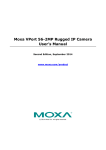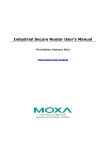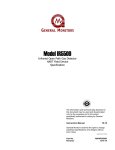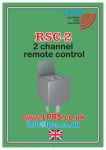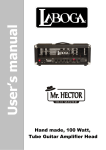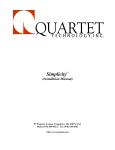Download The Synchro Diagnostic System user manual
Transcript
Page 1 of 6 The Synchro Diagnostic System user manual.doc 2002-07-02 The Synchro Diagnostic System user manual Table of contents THE SYNCHRO DIAGNOSTIC SYSTEM USER MANUAL 1 Table of contents 1 Introduction 1 Operation Nbr. Measurements left Read results Freeze measurement Restart measurement Poll result 2 2 2 3 3 3 Counter Settings Read Write 3 3 3 Reference Values Read Write 4 4 4 Signals Reference clock Start Stop 5 5 5 5 Time out 6 Introduction The Synchro Diagnostic system consists of an ECA (Diagc0) one or more Diagnostic Counters and a Switching Crate. The Diagnostic Counters are solely remote programmable measurement instruments, allowing measurement of Frequency, Period or Interval both using a known reference time-base (500MHz) or a user supplied timebase. Measurements can either be started synchronized by a timing signal or asynchronously. Also multiple measurements can be performed which can either be started as fast as possible, with a user defined interval (in ms) or synchronized by external timing. The Switching crate provides signal and timing signal multiplexing to allow execution of predefined (cabled) measurements. Typical users like PCR do not need the detailed knowledge on how to set up a measurement but can load archives, prepared by a specialist, containing the typical measurements they might require. In the current version only one diagnostic counter is available via the SPS-RFApplication (MMI) while the other three counters can be used manually. Manually operated counters only perform one measurement at a time. Note that even manual measurements also rely on the ECA to actually set- up the measurement, start it, convert the measurement data and write the converted data to the Diagnostic Page 2 of 6 The Synchro Diagnostic System user manual.doc 2002-07-02 Counter’s display module. This user manual intends to provide the required knowledge to allow a user to perform basic programming duties on the Synchro Diagnostic system. Not covered, in this writing, are the signals connected to the Switching Crate that are application dependant. The following chapters are structured like the SPS-RF-Application’s “RF Synchro Diagnostic” command tree. Operation All counter operation functions are grouped under this functionality. Nbr. Measurements left This Read only command returns the number of measurements left to be executed. This function is useful in case of lengthy multi acquisition measurements where the progress can be followed. Read results Read results, returns the measurement data if (all) measurement(s) are finished or a time-out has occurred. The measurement data is headed by: a Start and End timestamps as well as two strings: “measurement description” and “Reference value”. Below these the actual measurement data is displayed in 6 columns: • Measurement index (from 1 to N) • Measurement value • Unit o Hz: Absolute frequency measurement o ns: Absolute time of period or interval measurement. o M/R: Relative frequency -> Meas. count / Ref. count (ratio). o Ck: Relative time -> number of clocks. • Relative acquisition time (ms from start of measurement) • ms label • Status field (hexadecimal) o 0x0001: Clock present o 0x0002: Trigger present (only required for synchronized measurements) o 0x0004: Start of Frequency present o 0x0008: Stop or Frequency present o 0x0010: Measurement aborted o 0x0020: Reference counter overflow o 0x0100: Measurement counter overflow o 0x0200: Re-trigger before completion o 0x0400: Time counter overflow (non critical) o 0x0800: Measurement frozen o 0x1000: Bus control discontinued. If a measurement is underway there will only be a “Start” time-stamp followed by the “measurement description” and “Reference value” strings. In case of a time-out the “Start” time-stamp is succeeded by “Time-Out, NBRML=n”, where n is the number of measurements left at the moment of the time-out. The last measurement data field will show something like: “Acquisition error, Status: 0x0805”. The 8 indicates that this measurement has been frozen due to the time-out. Page 3 of 6 The Synchro Diagnostic System user manual.doc 2002-07-02 Freeze measurement This command stops a currently running measurement if any. Measurement performed until this freeze will be discarded since the ECA1 never gets a SRQ 2 from the concerned Diagnostic Counter. Restart measurement Restart measurement first issues a “Freeze” command and proceeds by starting (arming) the measurement. If the measurement is asynchronous it will start immediately while otherwise it will start upon reception of a Start trigger (timing). Poll result Poll result reads a status code from the ECA. This code is composed of the sum any of the following items: • (1) Time -Out. Set if a time-out has occurred. • (2) Local enable. Set if Local control is enabled on this Diagnostic counter. • (4) Measurement ready. Set if the measurement is ready. • (8) Resource used. Set if the counter has been reserved. Counter Settings Read Read Counter Settings reads the current settings from the hardware and displays them in a similar fashion as for the write case described below. Note: The value for the “measurement rate” field will read back as “65535” in the case of a written value of “–1”. All other settings will be similar as entered for write. Write The write Counter Settings command requires the user to enter to following 6 data fields: • Gate time . Select one out of 5 possible settings: o 1 s: enter 16, o 100ms enter 8, o 10ms enter 4, o 1ms enter 2, o 100us enter 1. Any other value will yield a conversion error from the ECA. • Nbr. Of measurements. Any number between 1 and 128 is accepted. In the current ECA software version however you should not exceed a value of 20 measurements. This current limitation is linked with the long internal data conversion process which in term (if too long) trips the hardware watchdog which will reset the ECA’s CPU. • Rate. The rate number corresponds to the measurement rate in ms. Rate can take any integer value between –1 and 1023 ms where –1 carries the special meaning: “As Fast As Possible”. 1 ECA= Equipment Control Assembly SRQ= Service ReQuest from a Diagnostic Counter signalling “measurement(s) ready” or a push on the front-panel “Start measurement” button. 2 Page 4 of 6 • • • The Synchro Diagnostic System user manual.doc 2002-07-02 N1_N2. The N1_N2 value is only meaningful for period and interval measurements and a don’t care for frequency measurements. o Period measurement. In this case N1+1 is the delay in number of pulses from the signal to be measured before the measurement gate opens. N2+1 is the number of pulses from the signal to be measured during which the gate stays open. o Interval measurement. The measurement gate opens N1+1 start input pulses after the start of measurement and closes after N2+1 stop input pulses. Both N1 and N2 can range from 0 to 15 and are packed in one integer. This integer is constructed as follows: value = N1 + 16 * N2. Remote (1) / Local (0). Set this value to 0 if you want to allow local control or to 1 if you only allow remote control. Notes: 1. Allowing local control does not prohibit a remote measurement. 2. A local measurement can apart from reading the display also be read back via remote. 3. A remote measurement also updates the local display. Mode . The mode setting determines the operation requested from the Diagnostic Counter. Mode is an integer ranging from 2 to 121 and is constructed by adding the codes of the option(s) required to configure the measurement. The Period, Interval and Frequency options are exclusive. o (1) Reference Clock. If this value is added the measurement will be of the absolute type, while otherwise the relative clock input is used. o (2) Period. Add this value if a period measurement is to be performed. o (4) Interval. Add this value if an interval measurement is to be performed. o (8) Frequency. Add this value if a frequency measurement is to be performed. o (16) Multi Shot. Add this value if more than 1 measurement is to be performed. Single shot if not added. o (32) Synchronous . Add this value if the measurement is to be started by a timing signal on the Start input. Otherwise the measurement starts as fast as possible. o (64) Multi Trigger. Add this value if each measurement in a Multi Shot measurement is to be started by an external timing. This option only makes sense if the Synchronous option is enabled/ Reference Values Read Read back the Measurement description and Reference value strings as written below. Write Write two strings called Measurement description and Reference value to the ECA. These strings are stored in RAM and become part of the measurement result data. Both strings are limited to a maximum of 52 characters. Measurement description can be used to briefly describe the signal and measurement type, while reference value would contain a typical expected value or range of values. Page 5 of 6 The Synchro Diagnostic System user manual.doc 2002-07-02 Signals All commands under signals are write only and manipulate the Switching crate. By connecting typical required signals to the Switching crate and the crate to the Diagnostic counter(s) signal selection, for the Diagnostic counter(s) can be automated through archived measurements. Reference clock Write only command allowing the user to select a Reference clock source from one of the Switching crate’s multiplexer card channels. Note that the card number selected should correspond to the external wiring from the Switching crate outputs to the concerned Diagnostic counter. Start Conditioning Write only command allowing the user to select a Start signal input multiplexer input. Data to be entered: • Card number (0..3). Selects one of 4 rear-panel cards. • Quartet (0..1). Selects a group of 4 inputs. A zero (0) addresses the top four inputs while a one (1) the lower four. • Channel number (0..3). Selects one of the four inputs, the top one being number 0. Switching Write only command allowing to select a Start signal source from one of the Switching crate’s multiplexer card channels. Note that the card number selected should correspond to the external wiring from the Switching crate outputs to the concerned Diagnostic counter. Stop Conditioning Write only command allowing to select a Stop signal input multiplexer input. Data to be entered: • Card number (0..3). Selects one of 4 rear-panel cards. • Quartet (0..1). Selects a group of 4 inputs. A zero (0) addresses the top four inputs while a one (1) the lower four. • Channel number (0..3). Selects one of the four inputs, the top one being number 0. Switching Write only command allowing to select a Stop signal source from one of the Switching crate’s multiplexer card channels. Note that the card number selected should correspond to the external wiring from the Switching crate outputs to the concerned Diagnostic counter. Page 6 of 6 The Synchro Diagnostic System user manual.doc 2002-07-02 Time out Write only command, writes the measurement time-out value, in seconds to the ECA. Allowed values are ranging from 1 to 1000s. A time-out sets a maximum limit to a complete measurement and if it expires, before the measurement has finished, the associated counter will be frozen and the appropriate time-out bit will be set. See also the section on Poll result. Upon a time-out: • The Diagnostic counter display will show “Time-out” with a time stamp. • The so-far completed measurement data is read from the counter and converted for exploitation by the Read results command, see also the section on Read results.






